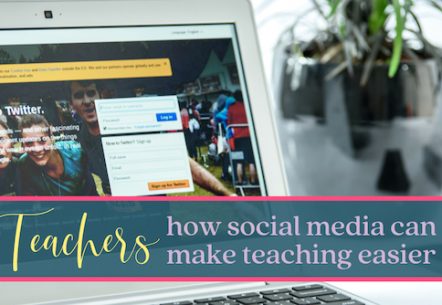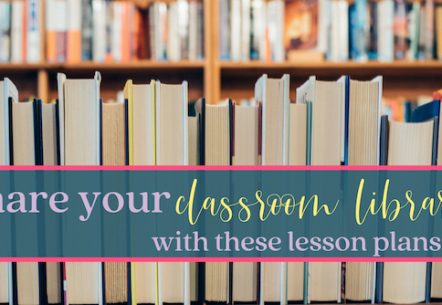After just one school year of weekly blogging in the classroom, I’m convinced that this is the best way to engage students in writing. Blogging has also been a fantastic way to build relationships with my students. The most beneficial classroom management tool for any teacher is having a positive relationship with their students. However, we all know that making time to cultivate these positive relationships with each and every student is time-consuming. That’s where blogging in the classroom can help! Consider how a student who writes a blog post about their favorite novel character gives you insight into their reading habits, interests, and their general outlook on life. Maybe they share a particularly difficult math concept the finally mastered. Perhaps they take photos of a recent piece of artwork and write about the process. Blogging is the perfect opportunity to assign writing for every grade level and every subject area.
As a blogger it’s customary to write with a conversational tone, making this an easy writing style for kids. My students were almost always more willing to write a blog post than to author an essay. But this activity is not just for English teachers, let me share why and how any educator can use blogging in the classroom.
Let’s start with a list of benefits (just in case you need to convince anyone blogging in the classroom is the right activity for you).
- Improved Literacy Skills: This is more of a byproduct of blogging. When you set specific expectations for what blogging looks like in your classroom and provide timely feedback to students their writing is going to improve. Of course, this could be said for any writing program. Blogging adds engagement for students through an authentic, global audience. When they are able to hear feedback from classmates, parents or anyone else who reads their public posts, students begin to write with a higher quality.
- Digital Citizenship: Blogs are now a part of nearly every brand with a website. Showing students what this concept looks like through a quality blogging program in your classroom will help them see the future job opportunities they could pursue. If you choose to include images with blog posts you’ll need to teach them about copyright laws. You are also showing them how to appropriately communicate online through posts and comments. This would hopefully transfer to their social media presence, as well. We have the opportunity to teach them how they can use their platforms for leadership opportunities rather than engaging in negative interactions.
- Authentic Writing Audience: We are always telling kids how important written communication will be for them and blogging is a great way to practice. The real world skills of writing for an actual audience, who is not a teacher giving them a grade, will help them see the fruits of their writing. Through comments, students can hear how people interpret their writing and how it helped them. There are several places teachers have joined together in sharing blogs and solicit comments. A special hashtag, #comments4kids, has been established and is frequently used by teachers who blog with students.
- Connect Home & School: Blogs are a great way to keep parents up to date on what their child is learning. Parents can tangibly see their child’s growth and progress that’s not an indistinct letter grade. Using the class blog to keep parents informed of the happening of each quarter or monthly learning can be helpful. We all know the school newsletter often goes from mailbox to trashcan. Whereas a blog might be more convenient for them to check from work or home and may provide more relevant, timely information for their child.
- Metacognition: A high level of thinking defined as “thinking about what you think.” Blogging takes on an editorial style of writing where students can share their opinions and thinking processes that took place on the way to establishing this opinion. Commenting on peer blog posts is another way to get kids thinking critically. They should learn how to make a connection and add something new to the topic in their comment. They will also need to learn the etiquette of disagreement.
These may have convinced you that blogging is a great idea, but it’s writing and you may not be a writing teacher. Let me share how every school subject could use blogging as a way to enhance their curriculum.
Science
Students could write blog posts that share an in-class lab. They could write in a step by step format so that other classes could replicate this lab. As a teacher, you’ll need to assess their knowledge so you could ask them to write a reaction to the outcomes of their lab. This could be preparation for students competing in Science Fair.
Social Studies
Rather than asking students to read about an event or person in a textbook they could each find research and documents to share within a blog. They could then make connections to how that aspect of history has played a role in today’s society. Students could even think through alternate historical outcomes and how that could have affected their lives. Let them become local historians and collect stories from the community to document on a blog.
Math
Students are always asking, “How am I going to use this one day?” Make this the focus of your blog and have students figure out how that math concept is used in the real world. Students could write tutorials as a way of providing homework help.
Music
Sharing videos of student choirs would be a wonderful way to showcase student talent. Students in Music Theory type classes could write informational blog posts about famous musicians, styles, and instruments.
Physical Education and Health
Students can blog about the history of different sports. They could invent their own sport or activity and provide details for playing. If there is a major sporting event taking place, like the Olympics, students could profile an athlete or sport. Students could write posts that could help their peers find support when dealing with difficult situations, and include resources for finding professional help. There might be a need for writing step-by-step instructions or a top ten list that other students would find helpful.
Art
This is another great way to showcase student talent and allow them to describe their process for creating the art. Students might write a profile for a famous artist, or better yet a local artist.
Foreign Language
Blogging would be a great way for students to write about the countries where the language they are learning is spoken. They could even partner with a classroom in those countries and write collaboration pieces. For the truly advanced students, they could write posts in the foreign language.
For any subject and grade level writing is always a great way to ask students to perform a summative assessment. You could create a prompt that asks them to share what they learned. For example: Pretend your table partner was absent, explain to them what knowledge they missed today. There are a number of ways to ask students to write. Providing students with an authentic writing experience, even when it may be for assessment purposes, gives them motivation for more thorough writing.
Still feeling overwhelmed? Let me help! I’ve created a Blogging with Students course that will walk you through each step for setting up a class blog and student blogs. I give you lesson ideas, video tutorials, and a full curriculum to get you through the school year. Go to the course site here for more information. Drop your email to stay updated on all things blogging with students.
Want to give blogging a try for yourself first? Start with a class blog. Sign up for my free 5-day email course. Each day I will walk you through the process of setting up a powerful class blog that parents will love and students will appreciate. You will get to see firsthand what blogging can do for your classroom.





